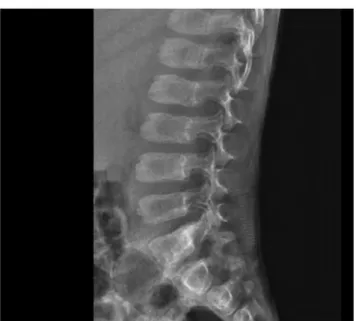CLINICAL QUIZ
Proteinuria and progressive kidney failure due to an inborn error
of metabolism: Questions
Özlem Ünal Uzun1 &Nurcan Cengiz2&Büşra Çavdarlı3&Umut Bayrakçı4&Saba Kiremitçi5& Aynur Küçükçongar Yavaş6
Received: 11 November 2020 / Accepted: 3 December 2020 # IPNA 2021
Keywords Child . Inborn error of metabolism . Anemia . Proteinuria . Dysostosis multiplex . Kidney disease . Cherry-red spot
Case summary
A 6-year-old patient was admitted to our clinic with a suspected diagnosis of an inborn error of metabolism (IEM). He was born at term with a birth weight of 3620 g with an uneventful delivery. He was the first child of non-consanguineous Turkish parents, and his sibling was healthy. He presented with fever 9 months ago and proteinuria; hepatosplenomegaly and lymphocyte vacuolation on periph-eral blood smear had been noticed incidentally. His motor and cognitive developments were normal. He was investigated at another clinic for a suspected metabolic disorder mainly mucopolysaccharidosis and mucolipidosis for accompanying clinical features. Urine glycosaminoglycan level and enzyme screening for mucopolysaccharidosis and mucolipidosis were normal.
At first admission to our clinic, weight was 17 kg (10–25 percentile) and height was 106 cm (3–10
percentile). On physical examination, he had a mildly coarse face. Liver was 8 cm, and spleen was 4 cm below costal margin. Routine laboratory investigations showed mild anemia, elevated urea levels, and protein-uria. Results were as follows: white blood cells 10.4 × 103/μL (4–12), hemoglobin (Hgb) 9.2 g/dL (11–14.5), mean corpuscular volume (MCV) 71.9 fl (76.5–90.6), platelets 164.000/μL (150–450), urea 65 mg/dL (11– 39), creatinine 0.45 mg/dL (0.5–1.2), iron 52 μg/dL (50–120), total iron binding capacity 274 ng/mL (110– 370), aspartate aminotransferase (AST) 27 U/L (0–50), alanine aminotransferase (ALT) 10 U/L (0–50), gamma-glutamyl transferase (GGT) 19 U/L (3–22), alkaline phosphatase (ALP) 154 U/L (93–300), uric acid 2.1 mg/dL (3.5–7.2), total protein 5.6 g/dL (5.7–8), albumin 3.1 g/dL (3.8–5.4), urinary protein 3+. Abdomen ultra-sonography showed upper limit of normal liver size, splenomegaly, bilateral nephromegaly, and bilateral in-creased renal parenchyma echogenicity. Skeletal imaging revealed dysostosis multiplex (Fig. 1). Ophthalmologic examination was initially normal. Chitotriosidase level was found highly elevated at the 5731 nmol/h/mL (0– 90) level. Bone marrow aspiration showed foamy cells indicating a storage disease. Leucocyte cystin content, glucocerebrosidase, and sphingomyelinase enzyme levels were normal. Twenty-four-hour urine protein level was 203 mg/m2/h and exhibited nephrotic range proteinuria. Five months after first admission, his creatinine level in-creased to 1.32 mg/dL and Hgb level dein-creased to 5.8 mg/dL, and he was hospitalized to investigate the underlying etiology of the kidney disease. Arterial blood pressure levels were ap-propriate for age. Erythropoietin and calcitriol treatments were commenced. In the follow-up period, kidney functions deteri-orated, and he became dependent on dialysis. Ophthalmologic examination was reevaluated and revealed cherry-red spot. The answers to these questions can be found athttps://doi.org/10.1007/
s00467-020-04901-z.
* Özlem Ünal Uzun unalozlem@gmail.com
1 Pediatric Metabolism, Kocaeli University, Umuttepe Yerleşkesi, Izmit/Kocaeli, Turkey
2
Pediatric Nephrology, Muğla Sıtkı Koçman University, Mugla, Turkey
3
Medical Genetics, Ankara City Hospital, Ankara, Turkey 4 Pediatric Nephrology and Metabolism, Ankara City Hospital,
Ankara, Turkey 5
Pathology, Ankara University, Ankara, Turkey
6 Pediatric Metabolism, Ankara City Hospital, Ankara, Turkey Pediatric Nephrology
https://doi.org/10.1007/s00467-020-04891-y
Questions
1. What would be the next diagnostics for the diagnosis? 2. What is your diagnosis?
3. What would you recommend to the family?
Compliance with ethical standards
Conflict of interest The authors declare that they have no conflict of interest.
Informed consent Informed consent was obtained from the parents of the patient.
Publisher’s note Springer Nature remains neutral with regard to jurisdic-tional claims in published maps and institujurisdic-tional affiliations.
Fig. 1 Anterior beaking of lumbar vertebrae consistent with dysostosis multiplex
Pediatr Nephrol
